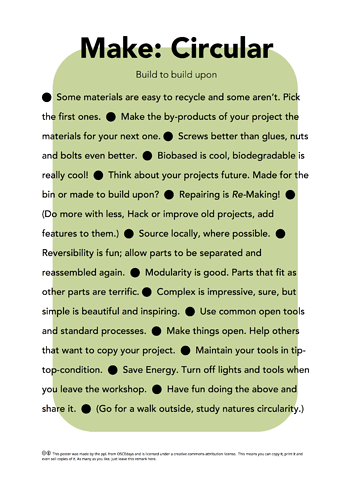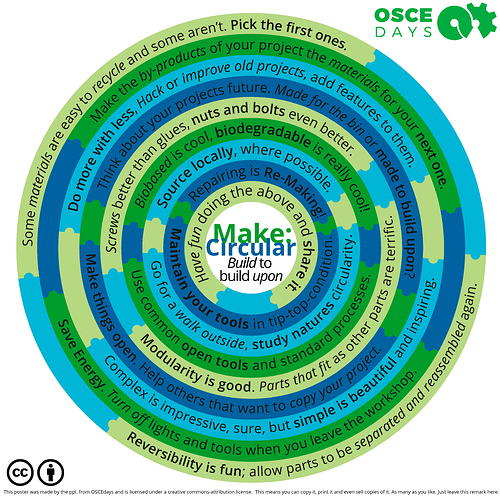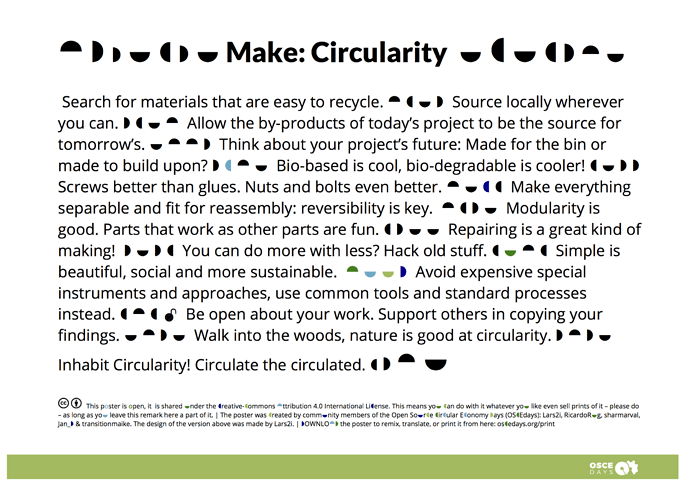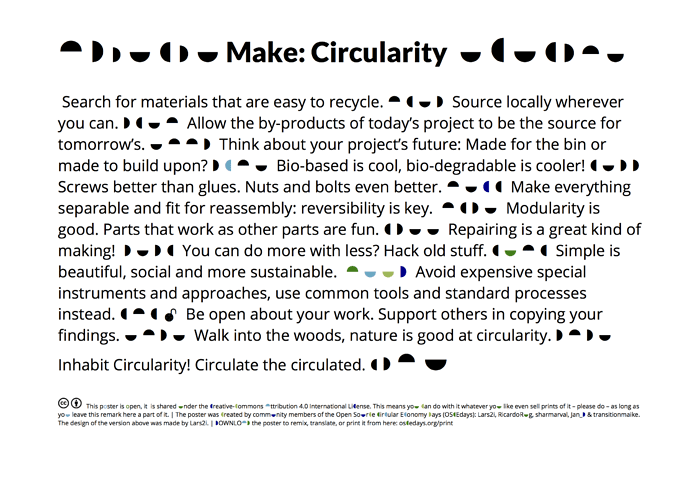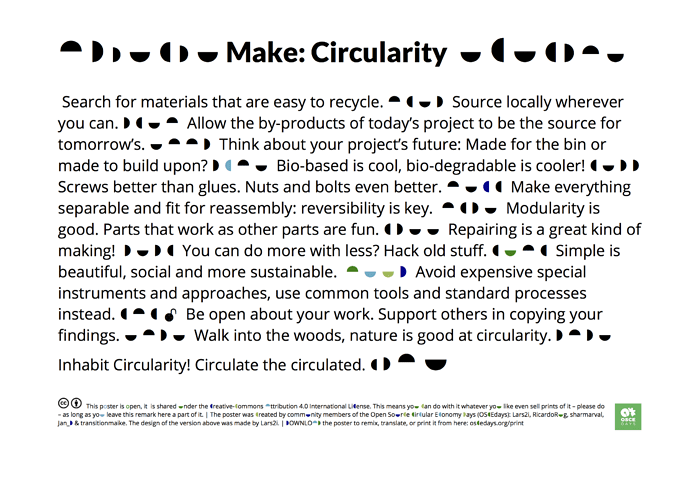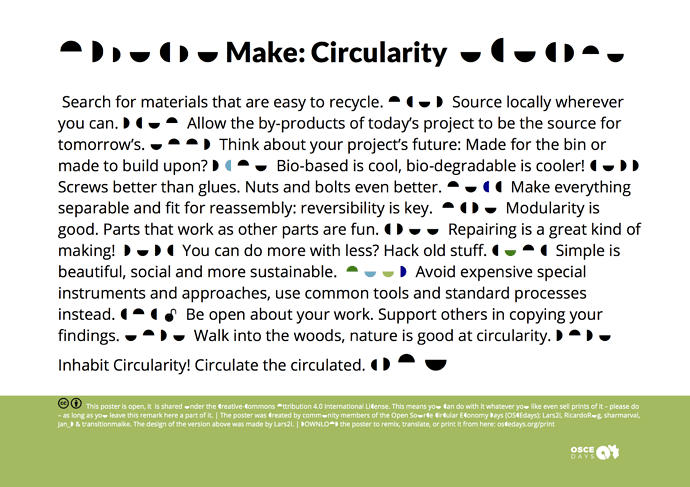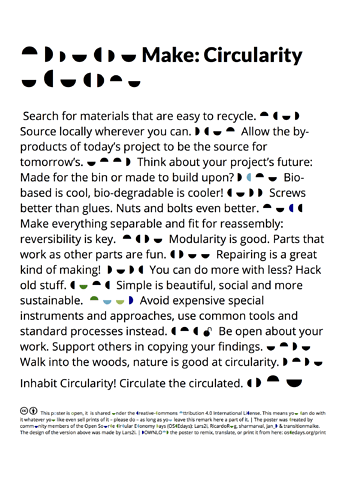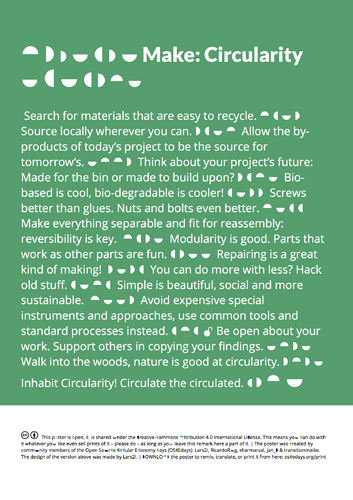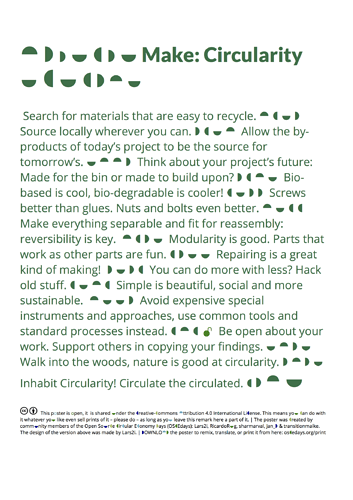In the London OSCEdays last year we looked at a “Making Decisions” style to go about this - a decision making tree style i.e. Is their a need for your product/ design if yes go on if no go back rethink  Initial (very sketchy) thoughts at the end of here with @Trystan_Lea @Grit @rachels42
Initial (very sketchy) thoughts at the end of here with @Trystan_Lea @Grit @rachels42
I’ve been involved in a BSI standard too that has laid out some highlevel principles alongside a section on design for circularity - mainly encompassing ecodesign elements
im Totally sure about those
(_) – Complex is impressive, sure, but simple is beautiful and inspiring.
(_) – have a walk in the woods. apply the circularity of nature.
7 – Source locally.
Use materials, technologies, knowledge, people who can contribute from your territory and its resources
10 – Use simple, and open, standards and common tools, sophisticated tools & solutions are barely ok.
11 – Make things open.
Develop the product so that it can be supplied, adapted, modified, reprocessed by others, allowing new actors to connect to a circular economic model.
13 – Turn off your tools and the lights when you leave your workshop. Save energy.
Intelligently use energy and resources, turn off your tools when you do not use them, draw by hand, save every kw of energy you can.
Design Meaning
()- That the projects you develop have a profound meaning, that contribute to the reality and the needs of those who use them, adapt and develop new ideas from these
()- Undertake projects together in a collaborative and open way, one head can generate good ideas, many can change the world!
()- Prototype your ideas, take them to a physical plane that allows you and others to understand, adapt and improve them. in the paper everything works, outside the details come to view.
()- Document the process of your work; can serve you to improve it, can serve others to apply it. Sketches, plans, photographs, tests, everything that you consider important share to the world.
I know it have to make them more concrete, but leave the idea.
On the other hand, what do you think if we apply the same system, graphic, poster or infographic for all OSCED tools?: action protocol, documentation, activity development, collaborative work, etc.
If I remember correctly in the first event, something similar was done for the document that explained how to document the activities.
Is this aimed at any person or org doing circular making, or more focussed on maker spaces and circular making within that context?
I think it would be cool if it was the former, but currently it feels written to be the latter 
I thought it to be for the latter. Just hobbyists and tinkerers. I think for organisations there are enough resources around on the topic.
The idea came when we discovered the OSCEdays Berlin will happen at the same time as Maker Faire Berlin. How to combine the two events - create synergies between them. Just a poster … made for hobbyists, who enjoy making in their free time. In the past decades there was a lot of debate about the ‘political’ or ‘economically’ power of ‘makers’. But if you go to a Maker Faire you see nothing of this. These are mostly just people having a hobby, just playing. It is a well working consumer-thing, perfectly fitting capitalism and linear economy. So the poster should be something easy and fun and inspiring just putting circular making on their radar without trying to force them… to save the world or something.
If the poster is done and well designed it could hang on the wall of fablabs and maker spaces. Just some “background” noise that might inspire a search or idea here and there.
true, @cameralibre made this poster. Good idea to extend the poster idea to supply events with content. I have already something in mind for the circular making poster. But let’s develop it first  - I am on the next iteration.
- I am on the next iteration.
Version 0.2
Hi all,
Thanks for the feedback and contributions in this and other channels.
Working with it I created a new iteration – see below.
What for
But before some explanations about the direction. What is it aiming for, who is it for?
- For hobbyists: As explained in the comment above. The target group should be makers and people who love building things but don’t connect it to sustainability or politics and don’t have an interest in doing so. The Maker Faire audience. Don’t burden them with the responsibility to ‘change the world’ – someone who wants that will understand that the list is also about that. Let’s not burden them with the task to ‘create meaning’ for others. All they should care about is that it means something to them. If it really does, chance is high, it means something for others too.
- Therefore it should be simple, straight and without much complex explanation. It should sound like an interesting challenge or question – own thought and search (!) inspiring. No boring tasks like demanding extended documentation for hypothetical and political motivated effects. If people are proud of what they have done they will share it anyway, the way they love to.
- Also if it is for hobbyists it should not talk about ‘products’. ‘Products’ – that sounds like work. If you think your project is cool and you are an entrepreneurial person the idea to make it a product will pop up naturally. If not, just enjoy yourself as a creative person.
Version 0.2
Ok, here is the new iteration of the bullet points. Probably they need to be in a different order.
Make: Circular / Make: Circularity
- Some materials are easy to recycle and some aren’t. Pick the first ones.
Make the by-products of your project the materials for your next one.
Screws better than glues, nuts and bolts even better.
Biobased is cool, biodegradable is really cool!
Think about your projects future. Made for the bin or made to build upon?
Repairing is Re-Making!
(Do more with less, Hack or improve old projects, add features to them.)
Source locally where possible.
Reversibility is fun; allow parts to be separated and reassembled again.
Modularity is good. Parts that fit as other parts are terrific.
Complex is impressive, sure, but simple is beautiful and inspiring.
Use common open tools and standard processes. (Avoid expensive special tools and solutions.)
Make things open. Help others that want to copy your project.
Maintain your tools in tip-top condition.
Save Energy: turn off lights and tools when you leave the workshop.
Have fun doing the above. And share it.
(Go for a walk outside, study natures circularity.)
And here is a draft for a possible direction of the poster (I am not a graphic designer clearly. This work will be added later.)
PDF: circular making poster design draft 01.pdf (50.8 KB)
DOC: circular making poster design draft 01.doc (39 KB)
let’s try to shorten the sentences into something that can stick in the mind as a slogan.
suggestions welcome 
I myself will wait a few more days till I get back to the sentences to get a little distance - and a fresh eye. Makes it easier to improve.
But would be great if there were already an improved version then 
[Some suggestions from me:]
Some materials are easily recycled. Some not. Pick the first lot.
Biobased is cool, biodegradable is cooler!
Source locally.
Modularity? You should! Parts that work as other parts are good.
Use commonplace tools and standard processes. (Avoid expensive special tools and approaches.)
Use the by-products from one project as the materials for another.
Think about your project’s future. Made for the bin or made to build upon? {This one, I think the second sentence works fine on its own}
Reversibility is clever; allows parts to be separated and reassembled forever!
New Source for inspiration:
###12 Principles of Permaculture - by David Homgren
btw. I am on a new iteration - including all feedback and suggestions.
Version 0.3
Here is a new iteration of the text. As short as possible! Maybe too short now. We should check if the sentences still make sense to new people. And add back in stuff where necessary.
@sharmarval @seigorobinson @Silvia @Gien @transitionmica – or any other native english speaker – could you pls. check the language and post a comment if you find something that needs to be corrected.
Title:
Making: Circularity
alternative title:
Make: Circularity
What do you think?
Content:
Build renewable resources:
–
Some materials are easily recycled. Some not. Pick the first ones.
_
Think about your project’s future: Made for the bin or made to build upon?
–
Source locally.
–
Allow the by-products of today’s project to be the source for tomorrow’s.
–
Biobased is cool, biodegradable is cooler!
_
Screws better than glues. Nuts and bolts even better.
–
Modularity is fun. Parts that work as other parts are good.
–
Reversibility is clever. Make everything separable and fit for reassembly.
–
Repairing is a great kind of making!
–
Simple is beautiful, social and more sustainable.
–
Avoid expensive special instruments and approaches, use commonplace tools and standard processes instead.
–
Hack and improve old projects. Do more with less.
–
Be open about your work. Help others to copy your findings.
–
Walk into the woods, nature is good at circularity.
–
Inhabit Circularity! Circulate the circulated.
or
Inhabit Circularity! Recycle the recycled. Reuse the reused. Repair the repaired.
Hi,
Here my feedback.
I like
- Walk into the woods, nature is good at circularity.
- Allow the by-products of today’s project to be the source for tomorrow’s.
Some of the words are a bit unusual (at least for a non native speaker). Here is of what I know the meaning of, but it seems a bit jargon-y:
- Source locally (What about: “Use local materials” or so?)
- Biobased (No good idea for an alternative, yet)
Some things could be more terse
- Some materials are easily recycled. Some not. Pick the first ones. could be : “Use materials which are easy to recycle”
- use commonplace tools --> common, widespread, normal, ususal
Others:
- Hack and improve old projects. Do more with less. I find “Do more with less” too generic. The sentence before on its own is sufficient.
some first thoughts on this one:
and I prefer:
Make: Circularity
##Version 0.4
Ok. Here is a new iteration including the fantastic feedback and suggestions by @Jan_D & @transitionmica
I have built the version I like most. Only thing still in question is the order.
Is the language correct in the two ones marked with *?
I am going to search for a design now. I think I am going to try to find a design made in Libre Office/Microsoft Word. So really everyone can edit it. And create translations for example. I am happy about suggestions for cool ways to use those programs for a poster.
#Make: Circularity
–
Source locally whenever you can. *
–
Allow the by-products of today’s project to be the source for tomorrow’s.
–
Think about your project’s future: Made for the bin or made to build upon?
–
Search for materials that are easy to recycle.
–
Bio-based is cool, bio-degradable is cooler!
–
Screws better than glues. Nuts and bolts even better.
–
Make everything separable and fit for reassembly: reversibility is key.
–
Modularity is good. Parts that work as other parts are fun.
–
Repairing is a great kind of making!
–
You can do more with less? Hack or improve old stuff.
–
Simple is beautiful, social and more sustainable.
–
Avoid expensive special instruments and approaches, use common tools and standard processes instead.
–
Be open about your work. Support others to copy your findings. *
–
Walk into the woods, nature is good at circularity.
–
Inhabit Circularity! Circulate the circulated. *
whenever?[quote=“Lars2i, post:22, topic:5836”]
Screws better than glues. Nuts and bolts even better.
[/quote]
Screws are better
Support others in copying your findings
#Design Drafts 0.1
Hi, I started looking for a design. Happy about feedback since this is really not my thing. I have two different main ideas. What do you think? (It is all made in MS Word/Libre Office)
CALL: If you are a designer and you want to take over the process. Pls. get in touch.
###DOWNLOAD
editable documents .DOC & .PDF of all drafts below
DOC and PDF First Ideas.zip (1.1 MB)
###DRAFTS
IDEA 1 – CROSSWISE
I1V1
I1V2
I1V3
I1V4
The half circles are used as an recurrent element. in the license they “want” to be seen as letters, in the main text they “want” to be seen as separators (and thus not as letters). They are not great imho as neither of those.
I find it is no sin if it should mainly look nice, but I assume it should be read, so I would suggest to try one or several of these:
- swap the circles for lines or so
- use a bulleted list with breaks before every point. Variations of the circle motive could serve as bullet.
I like the ones in Idea2 more and the clarity of the heading in I2V3 is good. I think that we need something like a symbol that graphically represents the concept: ‘Make:Circularity’ more: the OSCE logo does this well enough. This should be included anyway? But could also be used as the basis for the design?
I think the half circle separations are a nice idea, but agree the readability needs to be improved.
